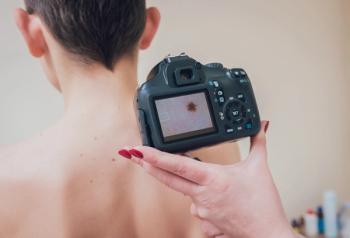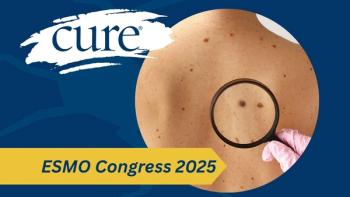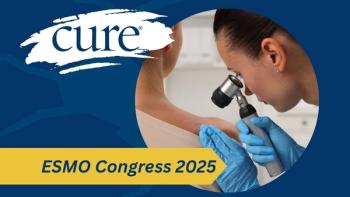
- Melanoma Special Issue
- Volume 1
- Issue 1
Beware the Beating Sun: Unprotected Sun Exposure Increases Risk of Skin Cancer
Using sunscreen and protective clothing are good preventive measures.
Kerrie Taber wasn’t a sun worshipper when she was growing up, and she’s definitely not one now, three-and-a-half years after being diagnosed with skin cancer’s deadliest form, melanoma.
But she did spend much of her summer during her Ohio childhood in her family’s backyard pool and, during soccer season, outdoors on the field perfecting her game.
Neither she nor her parents worried about the risks of unprotected sun exposure.
“We didn’t use sunscreen. Getting burned, et cetera, just wasn’t on our radar” of things to worry about, says Taber, a college professor at the University of Arkansas, Fort Smith, who lives in Arkoma, Oklahoma.
Taber, 44, had plenty of unfiltered time in the sun over the years, including her fair share of memorable childhood sunburns.
Doctors can’t say for sure how much of a role cumulative and intermittent exposure to the sun’s ultraviolet (UV) rays or her early sunburn history played in Taber developing melanoma, although chances are high that they were factors.
Research suggests that UV light from the sun and other sources like tanning beds figures into almost 90 percent of melanoma cases, according to the Melanoma Research Foundation.
Anyone Can Develop Melanoma
Genetics and a family history of skin cancer also make some people more susceptible to melanoma than others. Still, the strong link between UV exposure and melanoma, as well as other, more common but less aggressive forms of skin cancer, explains why dermatologists strongly advise people to take some simple, common-sense steps to protect themselves from UV light.The American Academy of Dermatology (AAD) emphasizes that anyone can develop melanoma, regardless of race or skin complexion. Therefore, everyone should take preventive measures against UV exposure, despite the fact that genetics and heredity are also believed to be risk factors.
These measures include limiting outdoor activity from 10 a.m. to 2 p.m., when the sun’s rays are most intense; seeking shade; and wearing broad-brimmed hats, long-sleeved shirts, pants and sunglasses.
Also, it’s wise to avoid tanning beds and sun lamps, because they rely on UV light, which can harm the skin and have been shown in numerous studies to increase melanoma risk, especially in long-term users who start tanning before age 35.
“Each time you tan, you are undergoing DNA damage,” says Steven Wang, director of dermatologic surgery and dermatology at Memorial Sloan Kettering Cancer Center in Basking Ridge, New Jersey.
To protect the skin, using the right type of sunscreen on a regular basis should be part of almost everyone’s UV-protection plan. The exception to the rule are babies 6 months old and younger. Their highly sensitive skin and higher surface-area-to-body-weight ratio make their exposure to the chemicals in sunscreen greater than that in older children and adults. The best way to protect babies from the sun is to keep them in the shade. If that is impossible, check with a doctor about how to apply sunscreen safely.
The rest of us should remember to use sunscreen even on cloudy, rainy and snowy days. That’s because the majority of the sun’s UV light, known as UVA, penetrates through clouds and even glass not treated with a UV filter.
Although there isn’t a broad range of long-term scientific studies on the benefits of sunscreen use in reducing the risk of developing melanoma, one landmark study found a dramatic correlation between daily sunscreen use and a substantially lowered incidence of the disease. The randomized study, conducted in Australia over a 10-year period and published in the Journal of Clinical Oncology in 2011, found that the number of new melanoma cases at the end of the trial period was twice as high among participants instructed to use sunscreen the way they always had as in the group told to use sunscreen daily. Eleven melanomas developed in the control group, compared with 22 melanomas in the daily-sunscreen group. There were 1,600 people in the study.
In addition, there were nearly four times more severe, invasive melanoma cases in the group that didn’t use sunscreen daily (11 invasive tumors) than in the group that did (three invasive tumors).
For people like Taber, who is fair-skinned and has more than 50 moles speckling her skin — many of them unusual, but at the moment not suspected to be cancerous — using sunscreen and other preventive measures is particularly important.
Broad-Spectrum Sunscreen Is Key
That’s because her skin type and the number and nature of her moles make her more likely than the general population to develop melanoma in the first place, and the risk of recurrent melanoma is high, according to the AAD.When it comes to sunscreen, experts advise focusing on several key elements.
One, look for a sunscreen with an SPF (sun-protection factor) of at least 30 and apply it to all exposed skin.
The SPF number refers to the percentage of the sun’s UV radiation the sunscreen blocks or absorbs, and has nothing to do with how long one application of the sunscreen will remain effective. An SPF 30 sunscreen works against 97 percent of UV radiation and those with higher SPF ratings are effective against slightly more, although no sunscreen is 100 percent effective.
Two, apply sunscreen 15 to 30 minutes before venturing into the sun, and reapply every two hours or as frequently as directed on the label.
Three, even if a sunscreen claims to be water-resistant, be sure to apply it every two hours, especially if you’re swimming or sweating a lot.
And four, make sure the sunscreen is labeled broad-spectrum, which means that it blocks both UVA and UVB light.
Both kinds of UV radiation damage the skin and have been deemed as human carcinogens by the World Health Organization and the U.S. government’s National Toxicology Program.
UVA rays, which have longer wavelengths than UVB rays, account for as much as 95 percent of the sun’s UV radiation that reaches the earth’s surface.
Due to its longer wavelengths, UVA radiation penetrates into deeper layers of the skin and has long been suspected of playing a major part in skin aging and wrinkling.
Recent studies also strongly suggest that UVA radiation can trigger and accelerate the development of skin cancers, according to the Skin Cancer Foundation.
UVB rays are responsible for burning and tanning, and they, unlike UVA rays, don’t penetrate glass and vary in intensity by season, location and time of day, with the highest concentration of UVB rays between 10 a.m. and 4 p.m. from April through October in the United States.
Choose a Sunscreen You Will Use
While it’s important to be aware of the harm that UV radiation can do and to take the proper precautions, that shouldn’t mean becoming fearful of the sun to the point of shunning it entirely. “When we talk about appropriate photoprotection (protection from UV light), I want to emphasize that we all should continue to participate in outdoor activities because psychologically, physically, it’s good for all of us,” says Henry Lim, chair of dermatology at Henry Ford Hospital in Detroit. “But put a photoprotection package (in place), protecting the skin from damaging effects of the sun.”In terms of sunscreen, as long as it’s got an SPF of 30 or higher and is broad-spectrum, the specific formulation is up to the individual.
The key thing for most people to consider is simply whether the sunscreen, be it a lotion, gel, cream or stick, is a product the user feels comfortable wearing so it will be used routinely, rather than sit forgotten in a cabinet or the bottom of a purse, experts say.
Yet people may want to think twice before using a spray. In June 2015, the U.S. Food and Drug Administration (FDA) announced that it was planning on studying spray products because of concerns about ineffective coverage and potentially harmful chemicals that could affect the lungs.
Despite our knowledge about the importance of adequate SPF levels, according to Wang of Memorial Sloan Kettering, “You’re better off picking even a broadspectrum SPF-15 sunscreen if you will use it regularly than buying a high-SPF sunscreen that ends up getting no use because you don’t quite like it.” But there is a caveat to this advice. People who are going to be out in the sun for extended periods or have had melanoma or another skin cancer should make use of a broad-spectrum sunscreen of SPF 50 or higher and reapply every two hours.
Sunscreen Ingredients: Upsides and Downsides
“The most important thing those individuals can do is try to avoid an extensive amount of UV exposure. Find shade, wear protective clothing and hats,” he says.The FDA has approved 17 active ingredients for sunscreen. They fall into two categories: chemical and mineral filters.
The most common sunscreens on the U.S. market contain chemical filters, which typically include a combination of two to six of the following active ingredients: oxybenzone, avobenzone, octisalate, octocrylene, homosalate and octinoxate. Mineral sunscreens use zinc oxide, titanium oxide or a combination of the two as UV blockers. There are also numerous sunscreens that synergize a combination of mineral and chemical buffers to protect users from UV damage.
Although all sunscreen formulations available for sale in the United States are considered over-the-counter drugs and are regulated by the FDA, there are advantages and disadvantages to both the chemical and mineral filters.
The chemical, or organic, varieties tend to be less visible on the skin once applied than their mineral, or inorganic, counterparts, which can leave a whitish stain, especially on darker-toned skin, until the sunscreen is rinsed away, Lim says.
So, cosmetically, the mineral-based sunscreens might be less appealing for some people.
On the other hand, mineral-based sunscreens almost never penetrate the skin and, in recent years, have had micronized formulations of their active ingredients that make them less conspicuous when applied than they have been in the past.
Chemical sunscreens are more likely than their inorganic counterparts to penetrate the skin, and some ingredients used in these sunscreens have been detected in mother’s milk, linked to hormonal interference and correlated to elevated rates of skin allergies, according to the Washington, D.C.- based environmental-health watchdog organization Environmental Working Group.
Nevertheless, both the FDA and leading dermatologists like Lim consider available broad-spectrum sunscreens, whether chemical or mineral in nature, to be safe and effective instruments against UV damage.
Still, the products available on the U.S. sunscreen market are less innovative than their counterparts in Europe and elsewhere. In fact, the FDA has not approved a new active ingredient for over-the-counter sunscreen use since the 1990s. Eight new sunscreen-ingredient applications have been filed with the FDA for general over-the-counter approval since 2002. Many of these products have been widely used for a decade or more in other parts of the world — but have yet to get the green light for general use in the United States.
Last December, President Obama signed the Sunscreen Innovation Act into law with the aim of getting the FDA to act on new sunscreen applications in a timely manner.
In response, the FDA told manufacturers it needs more data about all eight of the ingredients submitted for its review before it can approve them as generally safe and effective for their intended use in sunscreens.
For now, the American public will have to continue relying on the existing FDA-approved sunscreens.
Clothing for Protection, Skin Exams for Detection
“The stuff that we have now is good, but we can do better,” says Tim Turnham, executive director of the Melanoma Research Foundation. “We need more options.”In general, darker clothing and synthetic fabrics, such as nylon or polyester, and those with tighter weaves, like denim, offer a higher level of UV protection than more loosely woven, lighter-colored fabrics like cotton T-shirts.
And while all fabric filters UV radiation to some degree, some clothing is manufactured specifically to absorb or reflect UV radiation and rated with an ultraviolet protection factor (UPF) value. Apparel with a UPF of 40 or greater provides excellent protection, blocking 97.5 percent of UV radiation or more.
Having some UPF-rated clothing on hand is worthwhile, especially for people with a personal or family history of skin cancer or those with higher risk factors for its development, such as fair skin, blue eyes, red hair or a large number of moles.
Another easy way to protect yourself from melanoma is by conducting monthly 10-minute self-examinations for changes to your skin. This practice should be a routine for everyone, according to the Skin Cancer Foundation.
Examine your face, thoroughly inspect your scalp (with assistance from a friend or family member), your whole body, front and back, and even between your fingers and under the fingernails for changing or unusual-looking moles and lesions.
Make a simple map of your body, front and back, pinpointing the location of existing moles and markings so you can easily recognize new ones in future exams.
It might be worthwhile to have your first exam conducted by your doctor so he or she can help you identify potential trouble spots to watch. For those who already have known sun damage, or a history of melanoma or atypical nevi, special examinations by a dermatologist may be needed regularly.
Due to her melanoma history, Taber says she is vigilant these days about getting regular skin exams from her dermatologist and shielding herself from UV exposure.
She uses an SPF-50 sunscreen daily that is marketed for babies because it is fragrance-free and doesn’t sting her eyes.
But she doesn’t sacrifice her cherished outdoor time, which she values because she is in a running club and also regularly participates in 100- to 150-mile bicycle treks.
Still, she says, her brush with melanoma has altered her day-to-day life.
C
“You kind of change the way you look at things,” she says. “I’m trying to bring awareness to people within my scope. If I can help one person catch it before it becomes melanoma, then it’s good. I can make a difference.”
Articles in this issue
almost 10 years ago
For One Survivor, Melanoma Is the Source of Great Fear — and New Goalsalmost 10 years ago
Refresher Course: Getting Over Caregiver Fatigue to Prevent Burnoutalmost 10 years ago
Not-So-Routine Maintenance: Treating Melanoma After Surgeryalmost 10 years ago
Remember the Magic Wordalmost 10 years ago
Make That a Doublealmost 10 years ago
The Evolution of Melanoma Treatmentsalmost 10 years ago
Thin Skin: Children Need Special Protection From the Sun's Damaging Raysalmost 10 years ago
A Lifelong Journey: What It Means to Survive Melanomaalmost 10 years ago
Taking Melanoma by Stormalmost 10 years ago
First Words: Communicating With Loved Ones After a Cancer Diagnosis




